PONTIAC BONNEVILLE 2005 Owners Manual
Manufacturer: PONTIAC, Model Year: 2005, Model line: BONNEVILLE, Model: PONTIAC BONNEVILLE 2005Pages: 438, PDF Size: 2.71 MB
Page 351 of 438
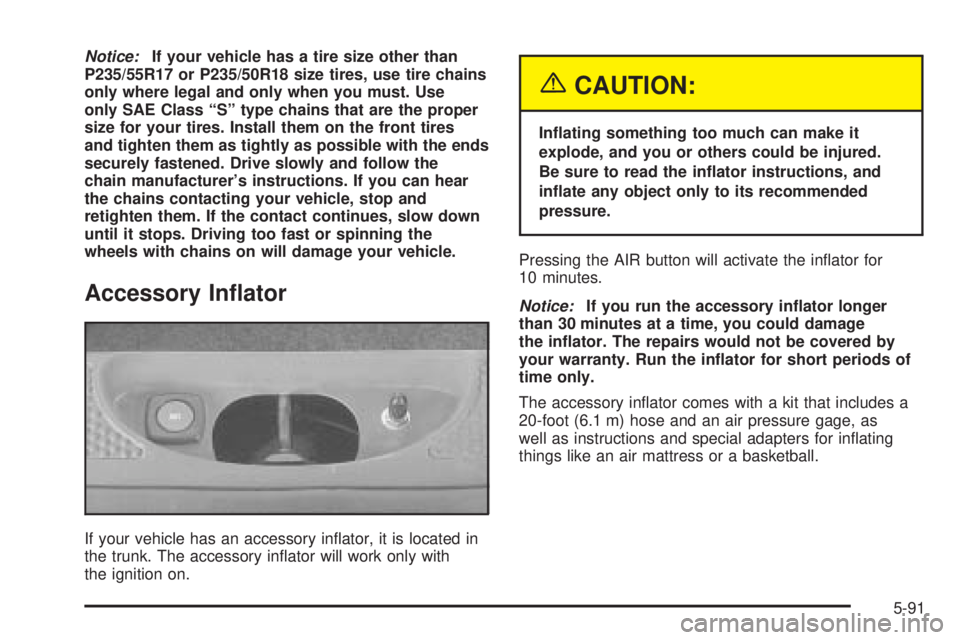
Notice:If your vehicle has a tire size other than
P235/55R17 or P235/50R18 size tires, use tire chains
only where legal and only when you must. Use
only SAE Class “S” type chains that are the proper
size for your tires. Install them on the front tires
and tighten them as tightly as possible with the ends
securely fastened. Drive slowly and follow the
chain manufacturer’s instructions. If you can hear
the chains contacting your vehicle, stop and
retighten them. If the contact continues, slow down
until it stops. Driving too fast or spinning the
wheels with chains on will damage your vehicle.
Accessory In�ator
If your vehicle has an accessory in�ator, it is located in
the trunk. The accessory in�ator will work only with
the ignition on.
{CAUTION:
In�ating something too much can make it
explode, and you or others could be injured.
Be sure to read the in�ator instructions, and
in�ate any object only to its recommended
pressure.
Pressing the AIR button will activate the in�ator for
10 minutes.
Notice:If you run the accessory in�ator longer
than 30 minutes at a time, you could damage
the in�ator. The repairs would not be covered by
your warranty. Run the in�ator for short periods of
time only.
The accessory in�ator comes with a kit that includes a
20-foot (6.1 m) hose and an air pressure gage, as
well as instructions and special adapters for in�ating
things like an air mattress or a basketball.
5-91
Page 352 of 438
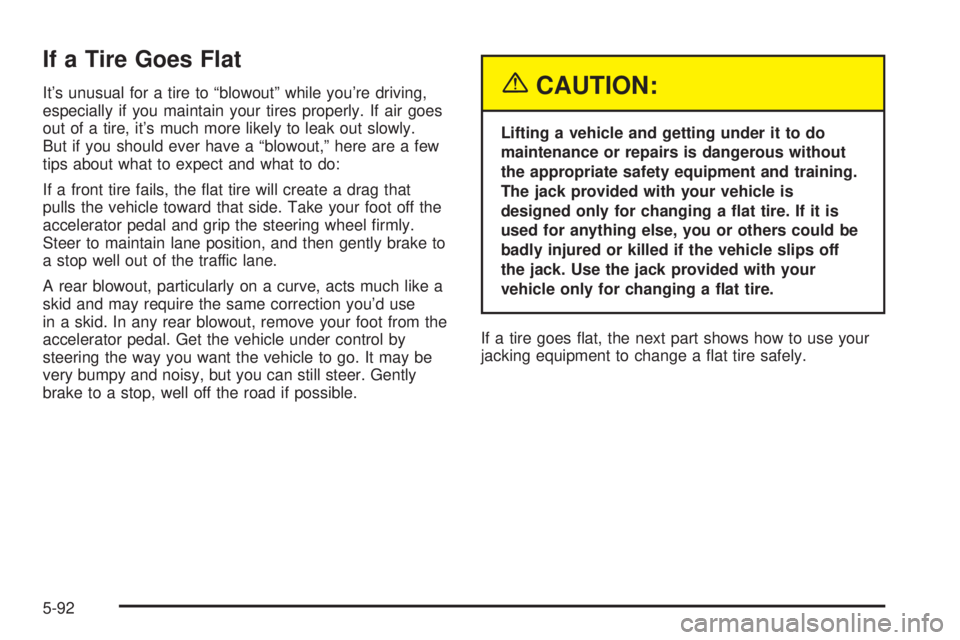
If a Tire Goes Flat
It’s unusual for a tire to “blowout” while you’re driving,
especially if you maintain your tires properly. If air goes
out of a tire, it’s much more likely to leak out slowly.
But if you should ever have a “blowout,” here are a few
tips about what to expect and what to do:
If a front tire fails, the �at tire will create a drag that
pulls the vehicle toward that side. Take your foot off the
accelerator pedal and grip the steering wheel �rmly.
Steer to maintain lane position, and then gently brake to
a stop well out of the traffic lane.
A rear blowout, particularly on a curve, acts much like a
skid and may require the same correction you’d use
in a skid. In any rear blowout, remove your foot from the
accelerator pedal. Get the vehicle under control by
steering the way you want the vehicle to go. It may be
very bumpy and noisy, but you can still steer. Gently
brake to a stop, well off the road if possible.{CAUTION:
Lifting a vehicle and getting under it to do
maintenance or repairs is dangerous without
the appropriate safety equipment and training.
The jack provided with your vehicle is
designed only for changing a �at tire. If it is
used for anything else, you or others could be
badly injured or killed if the vehicle slips off
the jack. Use the jack provided with your
vehicle only for changing a �at tire.
If a tire goes �at, the next part shows how to use your
jacking equipment to change a �at tire safely.
5-92
Page 353 of 438
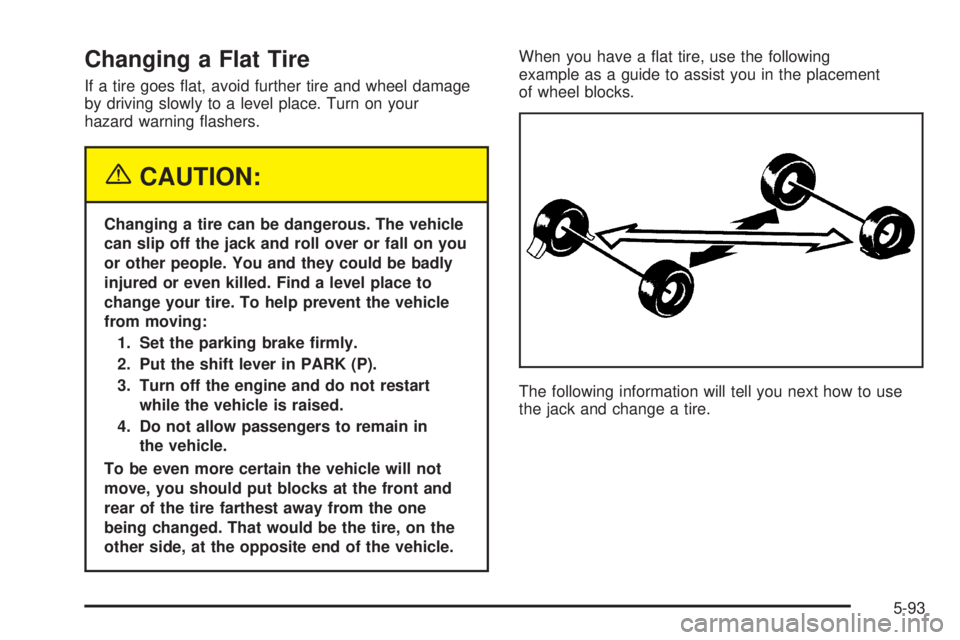
Changing a Flat Tire
If a tire goes �at, avoid further tire and wheel damage
by driving slowly to a level place. Turn on your
hazard warning �ashers.
{CAUTION:
Changing a tire can be dangerous. The vehicle
can slip off the jack and roll over or fall on you
or other people. You and they could be badly
injured or even killed. Find a level place to
change your tire. To help prevent the vehicle
from moving:
1. Set the parking brake �rmly.
2. Put the shift lever in PARK (P).
3. Turn off the engine and do not restart
while the vehicle is raised.
4. Do not allow passengers to remain in
the vehicle.
To be even more certain the vehicle will not
move, you should put blocks at the front and
rear of the tire farthest away from the one
being changed. That would be the tire, on the
other side, at the opposite end of the vehicle.When you have a �at tire, use the following
example as a guide to assist you in the placement
of wheel blocks.
The following information will tell you next how to use
the jack and change a tire.
5-93
Page 354 of 438
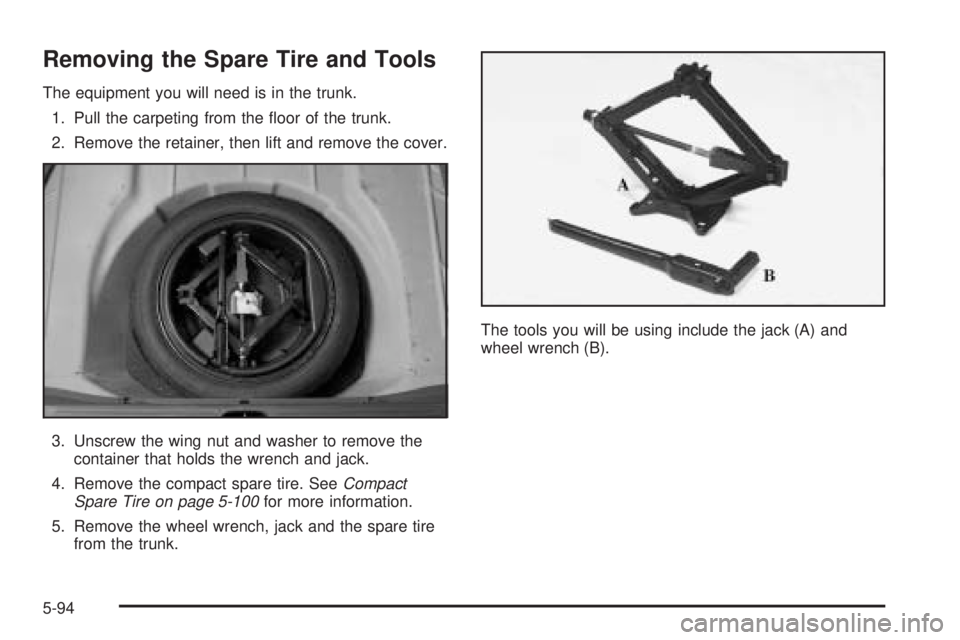
Removing the Spare Tire and Tools
The equipment you will need is in the trunk.
1. Pull the carpeting from the �oor of the trunk.
2. Remove the retainer, then lift and remove the cover.
3. Unscrew the wing nut and washer to remove the
container that holds the wrench and jack.
4. Remove the compact spare tire. SeeCompact
Spare Tire on page 5-100for more information.
5. Remove the wheel wrench, jack and the spare tire
from the trunk.The tools you will be using include the jack (A) and
wheel wrench (B).
5-94
Page 355 of 438
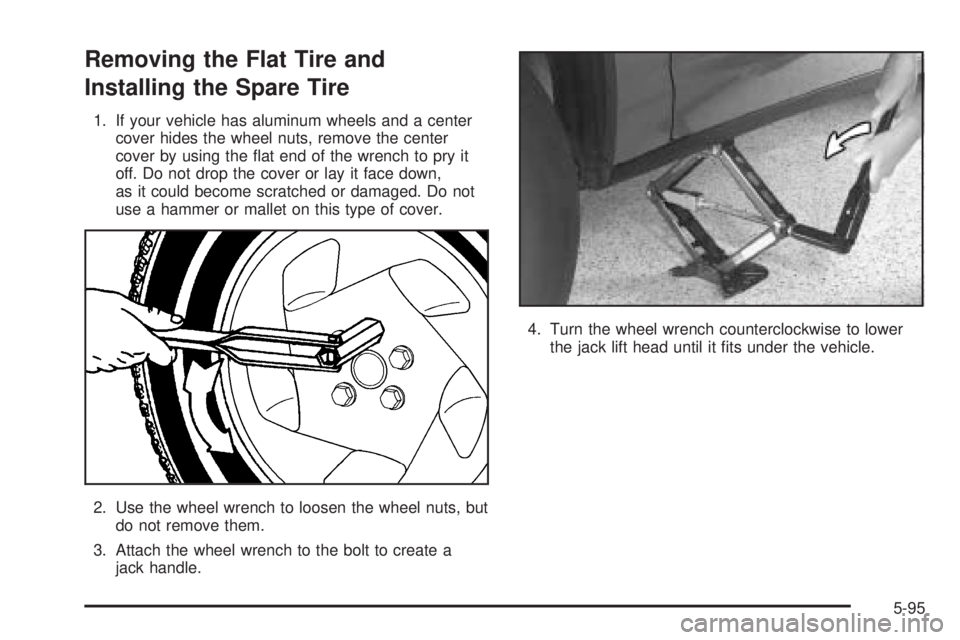
Removing the Flat Tire and
Installing the Spare Tire
1. If your vehicle has aluminum wheels and a center
cover hides the wheel nuts, remove the center
cover by using the �at end of the wrench to pry it
off. Do not drop the cover or lay it face down,
as it could become scratched or damaged. Do not
use a hammer or mallet on this type of cover.
2. Use the wheel wrench to loosen the wheel nuts, but
do not remove them.
3. Attach the wheel wrench to the bolt to create a
jack handle.4. Turn the wheel wrench counterclockwise to lower
the jack lift head until it �ts under the vehicle.
5-95
Page 356 of 438
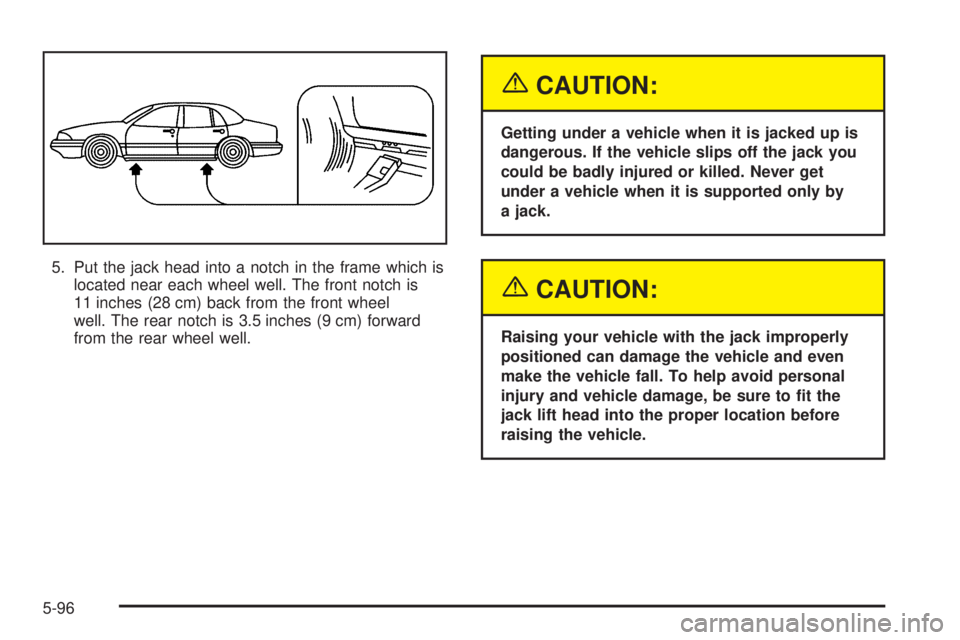
5. Put the jack head into a notch in the frame which is
located near each wheel well. The front notch is
11 inches (28 cm) back from the front wheel
well. The rear notch is 3.5 inches (9 cm) forward
from the rear wheel well.
{CAUTION:
Getting under a vehicle when it is jacked up is
dangerous. If the vehicle slips off the jack you
could be badly injured or killed. Never get
under a vehicle when it is supported only by
a jack.
{CAUTION:
Raising your vehicle with the jack improperly
positioned can damage the vehicle and even
make the vehicle fall. To help avoid personal
injury and vehicle damage, be sure to �t the
jack lift head into the proper location before
raising the vehicle.
5-96
Page 357 of 438
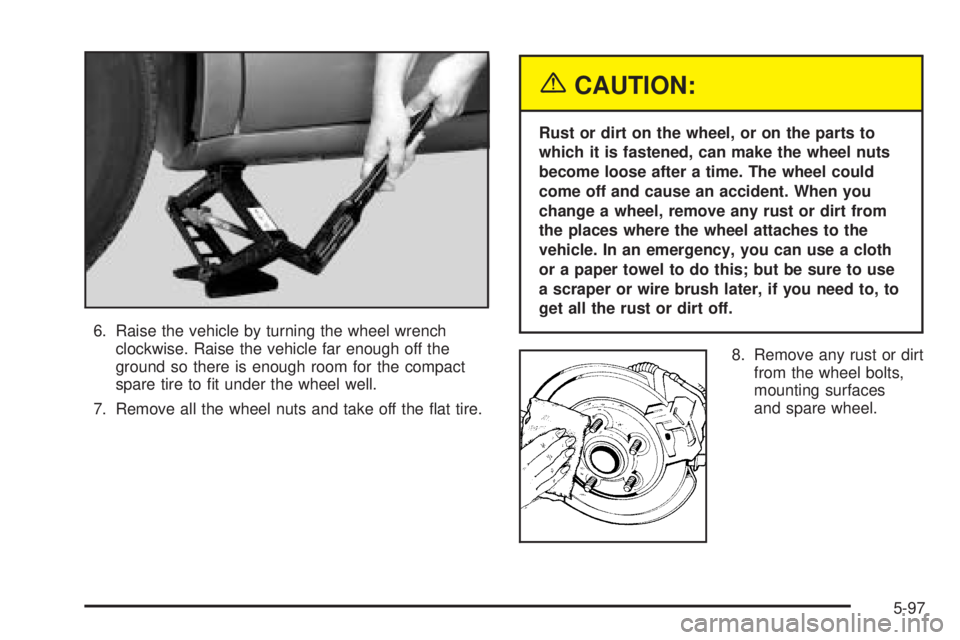
6. Raise the vehicle by turning the wheel wrench
clockwise. Raise the vehicle far enough off the
ground so there is enough room for the compact
spare tire to �t under the wheel well.
7. Remove all the wheel nuts and take off the �at tire.
{CAUTION:
Rust or dirt on the wheel, or on the parts to
which it is fastened, can make the wheel nuts
become loose after a time. The wheel could
come off and cause an accident. When you
change a wheel, remove any rust or dirt from
the places where the wheel attaches to the
vehicle. In an emergency, you can use a cloth
or a paper towel to do this; but be sure to use
a scraper or wire brush later, if you need to, to
get all the rust or dirt off.
8. Remove any rust or dirt
from the wheel bolts,
mounting surfaces
and spare wheel.
5-97
Page 358 of 438
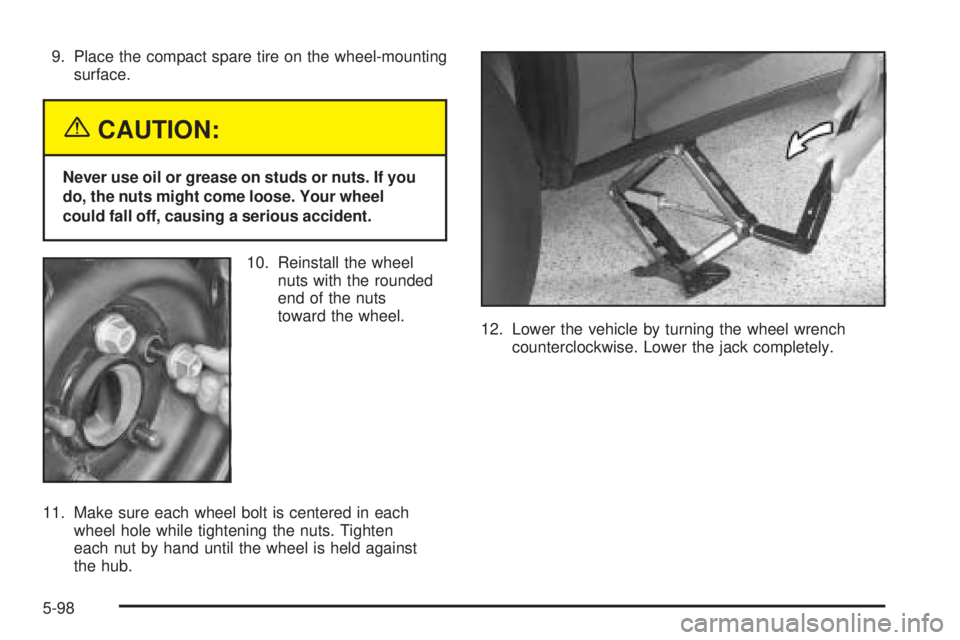
9. Place the compact spare tire on the wheel-mounting
surface.
{CAUTION:
Never use oil or grease on studs or nuts. If you
do, the nuts might come loose. Your wheel
could fall off, causing a serious accident.
10. Reinstall the wheel
nuts with the rounded
end of the nuts
toward the wheel.
11. Make sure each wheel bolt is centered in each
wheel hole while tightening the nuts. Tighten
each nut by hand until the wheel is held against
the hub.12. Lower the vehicle by turning the wheel wrench
counterclockwise. Lower the jack completely.
5-98
Page 359 of 438
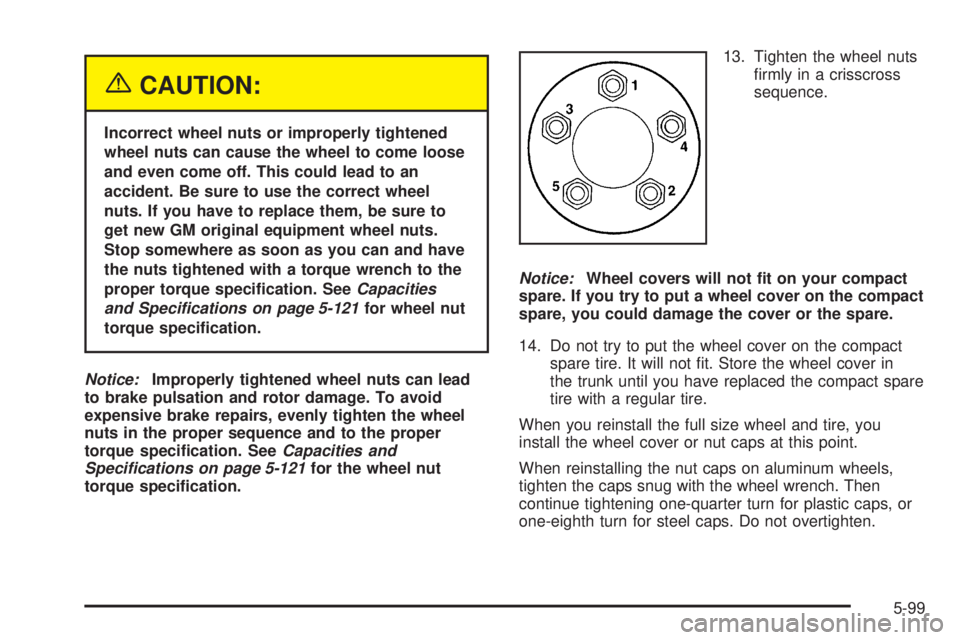
{CAUTION:
Incorrect wheel nuts or improperly tightened
wheel nuts can cause the wheel to come loose
and even come off. This could lead to an
accident. Be sure to use the correct wheel
nuts. If you have to replace them, be sure to
get new GM original equipment wheel nuts.
Stop somewhere as soon as you can and have
the nuts tightened with a torque wrench to the
proper torque speci�cation. SeeCapacities
and Specifications on page 5-121for wheel nut
torque speci�cation.
Notice:Improperly tightened wheel nuts can lead
to brake pulsation and rotor damage. To avoid
expensive brake repairs, evenly tighten the wheel
nuts in the proper sequence and to the proper
torque speci�cation. SeeCapacities and
Specifications on page 5-121for the wheel nut
torque speci�cation.13. Tighten the wheel nuts
�rmly in a crisscross
sequence.
Notice:Wheel covers will not �t on your compact
spare. If you try to put a wheel cover on the compact
spare, you could damage the cover or the spare.
14. Do not try to put the wheel cover on the compact
spare tire. It will not �t. Store the wheel cover in
the trunk until you have replaced the compact spare
tire with a regular tire.
When you reinstall the full size wheel and tire, you
install the wheel cover or nut caps at this point.
When reinstalling the nut caps on aluminum wheels,
tighten the caps snug with the wheel wrench. Then
continue tightening one-quarter turn for plastic caps, or
one-eighth turn for steel caps. Do not overtighten.
5-99
Page 360 of 438
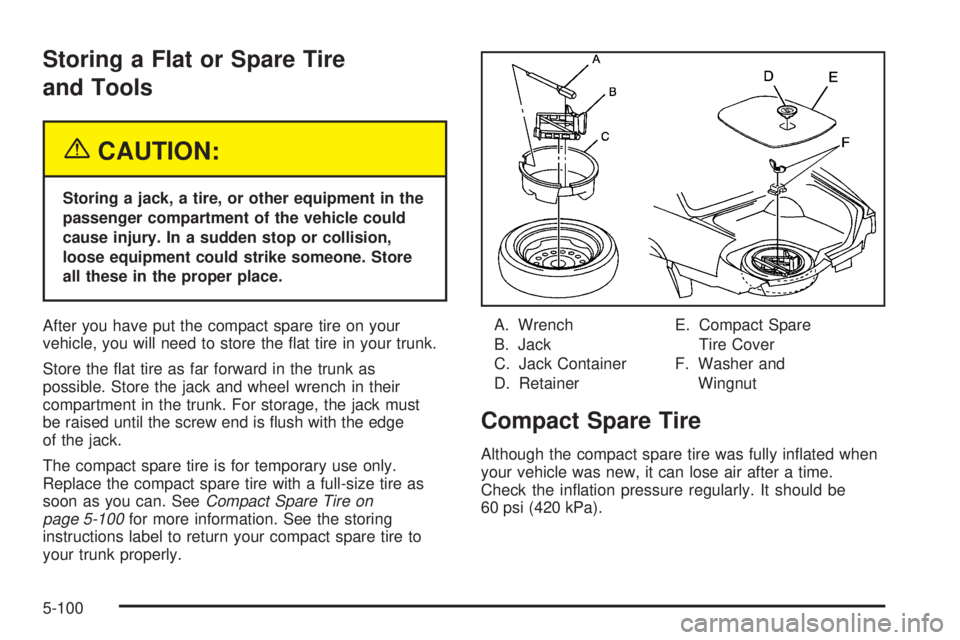
Storing a Flat or Spare Tire
and Tools
{CAUTION:
Storing a jack, a tire, or other equipment in the
passenger compartment of the vehicle could
cause injury. In a sudden stop or collision,
loose equipment could strike someone. Store
all these in the proper place.
After you have put the compact spare tire on your
vehicle, you will need to store the �at tire in your trunk.
Store the �at tire as far forward in the trunk as
possible. Store the jack and wheel wrench in their
compartment in the trunk. For storage, the jack must
be raised until the screw end is �ush with the edge
of the jack.
The compact spare tire is for temporary use only.
Replace the compact spare tire with a full-size tire as
soon as you can. SeeCompact Spare Tire on
page 5-100for more information. See the storing
instructions label to return your compact spare tire to
your trunk properly.A. Wrench
B. Jack
C. Jack Container
D. RetainerE. Compact Spare
Tire Cover
F. Washer and
Wingnut
Compact Spare Tire
Although the compact spare tire was fully in�ated when
your vehicle was new, it can lose air after a time.
Check the in�ation pressure regularly. It should be
60 psi (420 kPa).
5-100